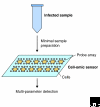Biochip sensors for the rapid and sensitive detection of viral disease
- PMID: 15960809
- PMCID: PMC1175961
- DOI: 10.1186/gb-2005-6-6-112
Biochip sensors for the rapid and sensitive detection of viral disease
Abstract
Recent advances in DNA and protein microarray methodology and the emerging technology of cell-based sensors have massively increased the speed and sensitivity with which we can detect viral infections. The advantages of the multi-parameter microarray technologies could be combined with the speed and sensitivity of cell-based systems to give 'cell-omic' sensors.
Figures



Similar articles
-
DNA biochip using a phototransistor integrated circuit.Anal Chem. 1999 Jan 15;71(2):358-63. doi: 10.1021/ac980043m. Anal Chem. 1999. PMID: 9949727
-
New oligonucleotide microarray for rapid diagnosis of avian viral diseases.Virol J. 2017 Apr 5;14(1):69. doi: 10.1186/s12985-017-0738-0. Virol J. 2017. PMID: 28381285 Free PMC article.
-
Identification of upper respiratory tract pathogens using electrochemical detection on an oligonucleotide microarray.PLoS One. 2007 Sep 26;2(9):e924. doi: 10.1371/journal.pone.0000924. PLoS One. 2007. PMID: 17895966 Free PMC article.
-
Nanotechnology: a new frontier in virus detection in clinical practice.Indian J Med Microbiol. 2008 Oct-Dec;26(4):297-301. Indian J Med Microbiol. 2008. PMID: 18974480 Review.
-
Molecular diagnosis of medical viruses.Curr Issues Mol Biol. 2007 Jul;9(2):87-102. Curr Issues Mol Biol. 2007. PMID: 17489437 Review.
Cited by
-
Fluorescence lifetime imaging of quantum dot labeled DNA microarrays.Int J Mol Sci. 2009 Apr 24;10(4):1930-1941. doi: 10.3390/ijms10041930. Int J Mol Sci. 2009. PMID: 19468347 Free PMC article.
-
Small Non-coding RNAs Associated with Viral Infectious Diseases of Veterinary Importance: Potential Clinical Applications.Front Vet Sci. 2016 Apr 4;3:22. doi: 10.3389/fvets.2016.00022. eCollection 2016. Front Vet Sci. 2016. PMID: 27092305 Free PMC article. Review.
References
Publication types
MeSH terms
Substances
Grants and funding
LinkOut - more resources
Full Text Sources
Medical

